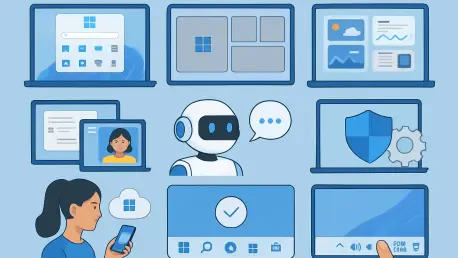I’m thrilled to sit down with Oscar Vail, a renowned technology expert whose insights into quantum computing, robotics, and open-source projects have positioned him as a leading voice in the tech industry. Today, we’re diving into Microsoft’s latest moves, from the end of free security support for Windows 10 to the exciting AI-driven updates in Windows 11. Our conversation explores the implications of phasing out older systems, the risks and solutions for users, the environmental concerns of tech transitions, and how cutting-edge AI features are reshaping the way we interact with our devices. Let’s get started.
Can you walk us through why Microsoft chose this moment to end free security support for Windows 10?
Well, Windows 10 has been around for a decade, which is a long lifecycle for any operating system. Microsoft likely decided now was the time because they’ve had Windows 11 out since 2021, giving users a reasonable window to transition. They’re also pushing hard to unify their user base on a platform that supports their latest innovations, like AI integration. Plus, maintaining security updates for an older system becomes resource-intensive over time. I’d estimate hundreds of millions are still on Windows 10 globally, especially in regions or sectors with older hardware that can’t upgrade easily.
What are the most significant dangers for users who stick with Windows 10 without those security updates?
The risks are pretty stark. Without updates, these systems are wide open to new vulnerabilities—think ransomware, phishing attacks, or malware that exploits unpatched flaws. Hackers often target outdated software because they know it’s a soft spot. Microsoft has urged users to upgrade, and for those who can’t, they’re offering some guidance, like paid support options or cloud-based solutions, but it’s not a perfect safety net. Users need to be extra vigilant with antivirus software and avoid risky online behavior.
Speaking of that paid support, can you break down how Microsoft’s extended security program for Windows 10 works until 2026?
Sure, Microsoft is offering extended security updates for Windows 10 until October 2026, but it’s not free for everyone. Businesses and individual users can opt in, though it’s a subscription model with costs that haven’t been fully detailed yet—expect it to scale based on the number of devices or user type. However, some get it free, like users in the European Union due to regulatory agreements, or those tied into Microsoft’s cloud services in the U.S. It’s a stopgap, not a long-term fix, meant to buy time for upgrades.
There’s been concern about the environmental fallout from ending Windows 10 support, with fears of massive electronic waste. How is Microsoft addressing this?
It’s a valid worry. When systems can’t run Windows 11, many users might just ditch their old PCs, contributing to toxic e-waste. Microsoft has acknowledged this and is encouraging recycling over landfill disposal. They’ve got partnerships and programs to help users recycle responsibly, though specifics vary by region. They’re also pushing messaging around sustainability, urging people to repurpose devices if possible—say, for lighter tasks or donating them—rather than tossing them out.
Shifting gears to Windows 11, can you explain the new AI features Microsoft is rolling out and how they change the user experience?
Absolutely, the standout updates revolve around their AI chatbot, Copilot. The “Hey, Copilot” voice mode lets you talk to your laptop directly—no typing or clicking needed—which feels like a sci-fi leap. Then there’s Copilot Vision, which analyzes what’s on your screen, offering real-time feedback on documents or even gaming tips. Imagine editing a report and getting instant suggestions, or playing a game and having AI guide your strategy. It’s about making interaction more intuitive and hands-free.
One Microsoft executive claimed that talking to laptops could be as revolutionary as the mouse or keyboard. What’s your take on that comparison?
I think there’s truth to it. Voice interaction with AI like Copilot isn’t just a gimmick—it’s a fundamental shift in how we engage with tech. Unlike past voice assistants, this is deeply integrated into the OS, understanding context and multitasking. That said, there’s a learning curve. In shared spaces like offices, users might feel awkward chatting with their laptop or worry about privacy. It’ll take time to normalize, much like the mouse did back in the day, but the potential to redefine workflows is huge.
How do you see these AI updates positioning Microsoft in the competitive landscape against other tech giants and innovative startups?
Microsoft is clearly doubling down on AI to stay ahead in a crowded field. They’re not just competing with traditional rivals like Apple or Google, but also with startups pushing generative AI boundaries. By embedding Copilot so deeply into Windows 11, they’re making their OS a gateway to AI tools, hoping to lock users into their ecosystem. It’s a smart play—Windows is still a dominant platform, and if they can make AI seamless, they could outpace competitors who are still figuring out integration.
Looking ahead, what’s your forecast for the evolution of AI in operating systems like Windows over the next few years?
I believe we’re just scratching the surface. AI in operating systems will likely become even more predictive and personalized, anticipating user needs before we even ask. Think of systems that not only respond to voice but adapt to your habits, optimize performance, or even mediate between apps for you. Microsoft will probably push for tighter hardware-software integration to make AI feel invisible yet indispensable. The challenge will be balancing that power with privacy and trust—users will demand transparency as these tools get smarter.









